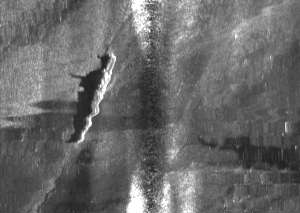August 20, 2006
Finding a submarine
One of the unfinished stories of World War Two may well be coming to a close. The USS Grunion dropped off the charts on July 30th, 1942. The three sons of its Captain never stopped looking for it and they may well have it located. From the Seattle PI:Lost submarine found off AlaskaVery nice human touch to the story:
Search for father may have turned up USS Grunion
There was no distress call, no indication of enemy depth charges exploding or bulkheads breached, just a dead silence that stretched from a few days into 60 years.
The USS Grunion disappeared in July 1942, leaving 70 American families grieving and the three sons of skipper Mannert L. "Jim" Abele without a father. Abele's boys -- who were 5, 9 and 12 and lived in Newton, Mass., when their father disappeared -- grew up and built their own lives. But they dwelt on the fate of their father.
At 2 a.m. Wednesday, a grainy sonar picture e-mailed via satellite appeared in Bruce Abele's in-box, appearing to show what they had searched for for much of their adult lives: the outline of an oblong object believed to be the Grunion deep in frigid Alaskan waters.
If the discovery is confirmed, it would signify a triumph of luck and perseverance, and put to rest a quest for clues that has spanned decades.
"It's big, very big," 76-year-old Bruce Abele, the eldest of the three sons, said Wednesday. "This mystery has been a part of my consciousness for as long as I can remember."
The Grunion, one of the Gato-class attack submarines commissioned early in World War II, was on its maiden operational voyage when it disappeared while patrolling the seas between Alaska's tip and Japan, according to a Navy Web site.
A break came in 2002, when a Japanese man, Yutaka Iwasaki, posted a translation of an article in an obscure Japanese shipping journal on one of several Web sites dedicated to the Grunion.They talked with Bob Ballard, hired one of the best Oceanic Survey companies (Williams and Associates in Seattle), hired an Alaskan Crab boat (the Submarine went down around around the Aleutian Islands -- horrible conditions more often than not) and proceeded to start searching. The sons run a website outlining their search efforts: USS Grunion Here is one of the preliminary sonar scans. You will see shadow distortion -- imagine looking at a toy sub on the floor with a flashlight held at an angle, the main body of the sub is to the right and the shadow of its superstructure extends off to the left:
The article, written by a military officer on board an armed Japanese merchant ship, the Kano Maru, described an exchange of cannon fire and torpedoes with a U.S. submarine in an area where the Grunion would have been patrolling.
Iwasaki's involvement changed everything, John Abele said Wednesday. Not only did the brothers have a place to look for their father's submarine, but they also had newfound friends from the other side of the war.
They were so inspired by the cooperation they received from Iwasaki and others in Japan that they decided to expand the search to find two Japanese sub-chasers, SC-25 and SC-27, that the Grunion sank, along with the Arare, a Japanese destroyer that went down in the same area.
"This has been a very emotional thing for a lot of us," John Abele said.
 Posted by DaveH at August 20, 2006 4:52 PM
Posted by DaveH at August 20, 2006 4:52 PM
Comments
Post a comment